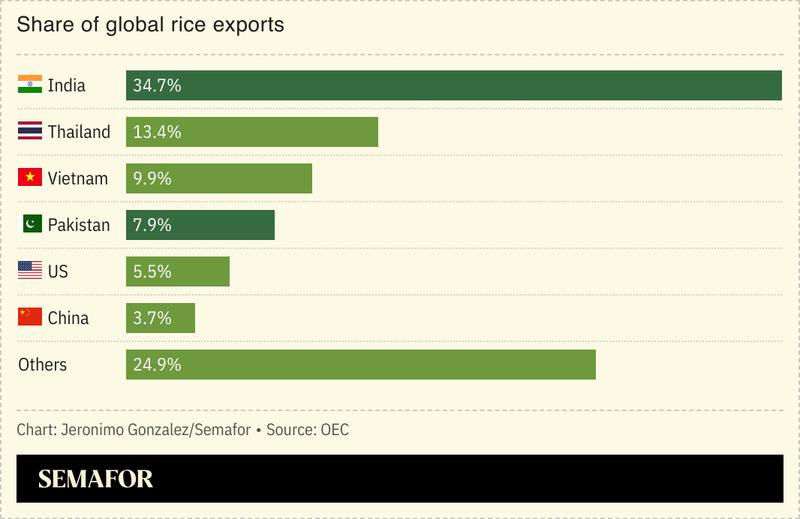The News
Global rice prices fell the most in 16 years after India — the world’s biggest producer — lifted some export restrictions, alleviating fears of worsening global food insecurity.
The decision was driven by better-than-expected harvests, and spurred rice exporters in Pakistan, Myanmar, Thailand, and Vietnam to slash prices to compete with the huge additional supply.
Food prices have begun to fall from their peaks following Russia’s 2022 invasion of Ukraine: The UN Food and Agriculture Organization’s food price index is about 25% lower than in March of that year.

SIGNALS
Pakistani rice exporters fear price battles
Pakistan was an “unintended beneficiary” of India’s export curbs, experiencing a more than 60% growth in rice export volume thanks to its emergence as an alternative supplier for countries across the Gulf, Africa, and Southeast Asia, Al Jazeera noted. Pakistan has since withdrawn its minimum export price (MEP), which would have undermined competitiveness with India back in the game, experts told the outlet. But local farmers, oppose the removal of the MEP: “Volume-wise, we cannot compete with India, so we should have maintained some price floor instead of removing it entirely. Now anyone can sell at any price, which could perhaps increase sales volume but drive prices down,” one said.
The climate crisis risks more food crises in the long term
If current trends continue, about 582 million people will be undernourished by the end of the decade, half of them in Africa, according to a recent World Health Organization report. Crops other than rice — like sugar, cocoa, and soybeans — have been badly hit by extreme weather, Bloomberg reported. Climate change is driving long-term fluctuations in food supply, and only “developed breadbasket regions” in the Global North have the adaptive capacity to weather the storm, a climate scientist told PBS. The decline of crop yields could spur more export curbs and “nationalistic behavior” among producers as they try to address domestic food crises, a researcher told Time.
Starbucks takes hands-on approach to climate-proofing coffee
Coffee chain Starbucks is purchasing two farms in Costa Rica and Guatemala to act as living labs, where researchers will investigate different technologies — drones, soil restoration, water systems — and coffee varieties that could make the bean’s production and harvest more resilient to climate change, Bloomberg reported. Dry spells in Brazil, where Starbucks’ favored arabica coffee varietal grows, sent the price of the beans to their highest in about a decade in September, and while the chain locks prices months in advance, insulating it from fluctuations, “if we don’t build resilience today, the reality is that the availability of coffee will continue going down,” the company’s vice president said.



